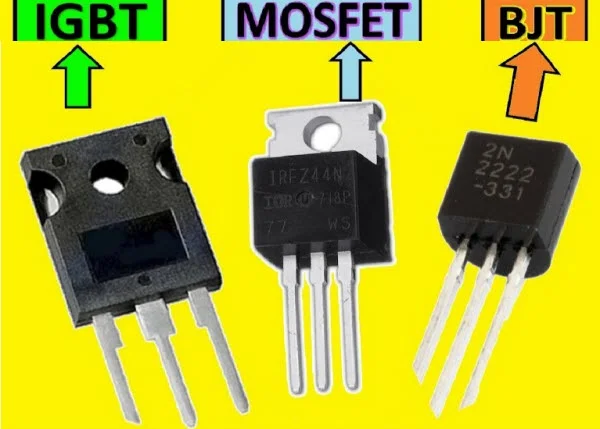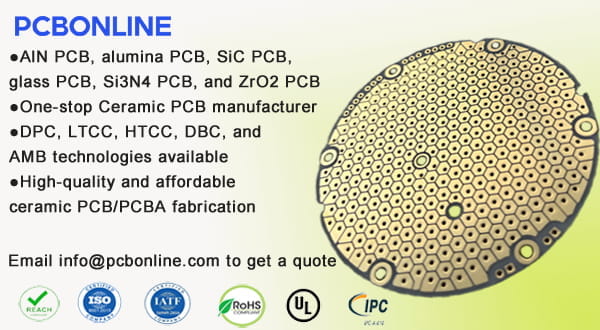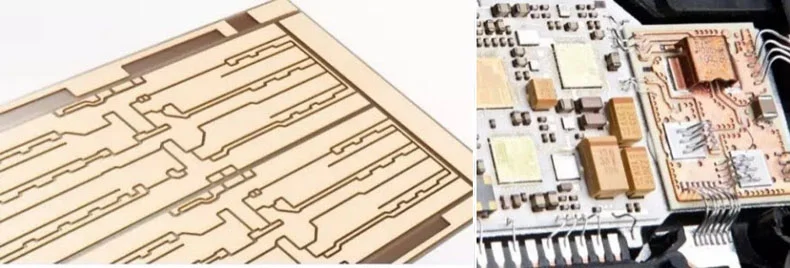
IGBT, or Insulated Gate Bipolar Transistor, is a BJT transistor with an MOS Gate, or we can say an IGBT module is a combination of a BJT and an MOS Gate. An IGBT chip is small in size, but it can control electrical energy transmission and achieve 100,000 times of current switch at ultra-high voltages of 650 million V in only 1 second.
IGBT modules have been applied in automotive, industrial, aerospace, consumer electronics, and many other industries for many years. But how to optimize the thermal dissipation of an IGBT package so the module can work at a higher power? If thermal can dissipate more quickly, the IGBT module can have more advanced applications. For this purpose, engineers are using ceramic PCBs for IGBT packaging.
Ceramic PCBs dissipate thermal from the IGBT chip to the outer packaging
You may ask, how much thermal does an IGBT module generate when it works? It is equal to the heat generated by 100 electric furnaces. So much thermal has to be dissipated immediately from the IGBT chip which leads to the application of ceramic PCBs.
How does a ceramic PCB protect the IGBT module from heat? In an IGBT module, a ceramic PCB is placed under the IGBT chip, or we can say that the chip is assembled on the ceramic circuit board. The ceramic PCB connects and supports the chip and dissipates thermal quickly from it to the outer packaging. In this way, the chip is protected from the influence of thermal.
Why Ceramic PCBs can be used for IGBT thermal dissipation

There are alumina (Al₂O₃) PCBs, aluminum nitride (AlN) PCBs, and silicon nitride (Si₃N₄) PCBs used for thermal dissipation of IGBT modules.
Why ceramic PCBs can dissipate thermal effectively for the IGBT module? Because ceramic materials have good properties of thermal dissipation and electrical insulation. Unlike aluminum substrate PCBs, ceramic PCBs do not use an insulation layer that hinders thermal dissipation. During the ceramic PCB manufacturing process, the copper-clad is directly bonded onto the ceramic substrate at high temperatures under high pressures. Then the circuit layer is manufactured by the photoresist coating method. When the circuit board is manufactured, the IGBT and other components are mounted on the board. Ceramic materials have ultra-high insulation and can withstand breakdown voltage up to 20KV/mm. The thermal conductivity of alumina PCBs is 15-35W/mK, aluminum nitride PCB 170-230W/mK, and silicon nitride PCB 80+W/mK. On the contrary, an aluminum PCB has a thermal dissipation of only 1-12W/mK.
Application of ceramic PCB for IGBT packaging
Alumina PCBs are the most used circuit boards for IGBT modules because of their lower prices. If the IGBT module has a higher power or precision requirement, aluminum nitride and silicon nitride PCBs are used. Aluminum nitride PCBs and silicon nitride PCBs have higher thermal dissipation and close the thermal expansion coefficients with semiconductors. Depending on the needs of IGBT modules, different ceramic substrate circuit boards are applied.
The new semiconductor silicon carbide (SiC) and gallium nitride (GaN) are beginning to be used for IGBT chips. The SiC and GaN IGBT chips are featured with high-frequency, high-power, and high temperatures. In the future, aluminum nitride PCBs and silicon carbon PCBs will be applied more for high-density three-dimensional packaging of high-power IGBT modules.
No matter how different the requirements of the IGBT modules to the ceramic PCBs, the ceramic circuit boards should have these characteristics:
- The ceramic substrate has excellent thermal conductivity and voltage resistance;
- The copper circuit layer has an extremely high current-carrying capability;
- Between the circuit layer and the ceramic substrate, there is strong adhesion and reliability;
- The welding performance is good, and the board is suitable for aluminum wire bonding.
PCBONLINE: One-Stop Contract Manufacturer for IGBT Modules

PCBONLINE is one of the leading one-stop ceramic PCB manufacturers in China. It provides electronics contract manufacturing for IGBT modules from prototypes to large-scale production. Most of PCBONLINE’s ceramic PCBs manufactured for IGBT modules are aluminum nitride PCBs and silicon nitride PCBs.Clients give a high rating to PCBONLINE. Here are the reasons to choose PCBONLINE as your IGBT module contract manufacturer:
- PCBONLINE provides all types of ceramic PCB solutions for IGBT modules, including aluminum nitride, alumina, silicon nitride, and hybrid substrates.
- Free DFM checks before giving a quote to clients, which fully makes sure the IGBT module won’t be affected by thermal in your design.
- Better welding performance and more high-temperature resistance of the ceramic PCBs.
- PCBONLINE adopts the DPC technology to achieve 3D design for IGBT module packaging.
- PCBONLINE can manufacture ceramic PCBs to be HDI.
- All levels of production are of the same high quality.
- 100% successful IGBT contract manufacturing guarantee.
Showcase of ceramic substrate PCB for IGBT thermal dissipation

- Name: IGBT ceramic substrate PCB
- Material: aluminum nitride/silicon nitride
- Surface technology: nickel palladium gold/OSP
- Product features: 1. High thermal conductivity and high-pressure resistance. 2. High adhesion strength between ceramic and metal and excellent welding performance. 3. High substrate flatness and good product stability.
Conclusion
Adopting ceramic PCB is the main method to dissipate thermal and protect the IGBT chip from overheating. If you plan to develop IGBT modules, choose PCBONLINE as your ceramic PCB provider and IGBT contract manufacturer.
Related Content:




